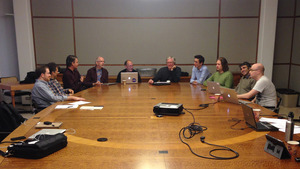ELSI Blog
76 Towards a Modeling Origins of Life (MOL) Community
 Last summer we had a two-week workshop in Tokyo, sponsored by ELSI, followed by a three week workshop in Kobe, sponsored by RIKEN, on the topic of Modeling Origins of Life (MOL). These five weeks together formed a "working workshop", in which the participants were encouraged to engage in joint research. Early in the first week, a number of working groups formed spontaneously, each one focused on a different research topic. Each participant could take part in different working groups, dividing his or her time over different topics, and from time to time new groups formed dynamically.
Last summer we had a two-week workshop in Tokyo, sponsored by ELSI, followed by a three week workshop in Kobe, sponsored by RIKEN, on the topic of Modeling Origins of Life (MOL). These five weeks together formed a "working workshop", in which the participants were encouraged to engage in joint research. Early in the first week, a number of working groups formed spontaneously, each one focused on a different research topic. Each participant could take part in different working groups, dividing his or her time over different topics, and from time to time new groups formed dynamically.
MOL was launched in a one-day pilot workshop in March in Princeton at IAS, the Institute for Advanced Study, one of the two ELSI satellites outside Japan. This was the trigger for the five week summer workshop, and the success of the latter led us to consider how we could further nurture the budding new MOL community. To this end, half-way the summer workshop a new working group was formed with the explicit goal of MOL community building through various ongoing activities.
Two weekends ago, this working group held a weekend reunion at IAS, with ELSI members Nathaniel Virgo and Matthieu Laneuville flying over from Tokyo, joined by Jim Cleaves and me as current ELSI members and Eric Smith who will start working at ELSI early next year. In addition, another half dozen alumni from the summer workshop joined in, together with new participants including Chris Adami, well known for developing Avida, an artificial life simulation program; Chris also give the first keynote speech at the 2nd International ELSI Symposium, in March.
The most tricky question, one we had started to ask already in Kobe, was how to define the scope of Modeling Origins of Life. Originally, the idea for MOL had come up during a 3-day workshop in January at ELSI. At that time we thought mainly about computer simulations to address the origins of life on a somewhat more abstract or `meta' level, the kind that physicists sometimes call toy models, in an attempt to isolate the most essential properties of complex systems. However, in Kobe all three letters of MOL were scrutinized to see how far these ideas could be pushed.
First of all, the notion of MODELING could include experiments as well as computer simulations. After all, in biology we talk about model organisms, such as drosophila or mice. In this spirit, oil droplet experiments could form very simple models for the origin of the most primitive living cells.
Secondly, a study of ORIGINS could be extended to other major transitions along the way from prebiotic chemistry to complex organisms like plants and animals. The origin of photosynthesis and the origin of multicellularity are just two examples. And the origins of life itself are likely to consist of a number of partially overlapping transitions, which together resulted in the emergence of the last universal common ancestor (LUCA) of all cells that are alive today.
Thirdly, a study of origins of LIFE, on a more abstract level, has a lot in common with the question of origins of other complex life-like processes in nature and in culture. The emergence of human languages and after that the invention of written scripts show clear parallels with the emergence of DNA as the carrier for the genomic code; many biological metaphors, such as translation and transcription, in fact borrow cultural terms. The origins and evolution of companies and other social organizations also offer rather obvious parallels.
Applying all three extensions led us to consider in Kobe an alternative acronym TULP, for Transitions in Universal Life-like Processes, leaving the notion of modeling open-ended. However, during the last weekend workshop we decided to stick with the original MOL name, given the simple descriptive character of the name, while acknowledging the three possible ways of extending the original concept.
The most important upshot of our workshop was a concrete set of plans we made on the second day, to organize a MOL conference in the fall of 2015. So far, in the last eight months, our MOL workshops have not been publicly announced. Although anyone was welcome to join us, in practice this led to most participants having been invited specifically to partake in the so far still rather experimental phase of MOL.
Next year the time will be ripe for a public `coming-out' conference, which will put MOL on the map amidst many partially overlapping areas such as the more general fields of origins of life, artificial life, various aspects of studies of evolution, systems science, complexity studies, social network theory, and cognitive science, to mention a few.
I am very pleased to see how the collaboration between ELSI and its Satellite, the Program in Interdisciplinary Studies at IAS, has formed an incubation environment for MOL to be conceived, first, and to take shape in a series of workshops throughout this year.











